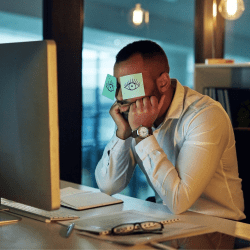9 Tips to Hosting More Effective Team Meetings

Team meetings are intended to promote communication and creativity amongst company departments and teams. At times though, employees can view some meetings as a waste of time. Many employees could relate to a social media meme that started to circulate a few years ago. The meme featured actress Viola Davis with an annoyed look on her face and a caption that read, “That look you make when the staff meeting could have been an email.”
No employer or manager wants to run an ineffective meeting; unstructured and inefficient meetings are a waste of everyone’s time, impede employee morale, and unnecessarily increase labor expenses. Use these nine tips to ensure your team meetings are more effective for your company and its employees.
Tip #1: Determine The Meeting's Purpose Early On
Start by asking yourself the “why” for the meeting. Is the purpose of the meeting to generate new ideas? Are you trying to gather information from key players to make tough decisions? The most critical factor in running an effective meeting is having a clear vision and setting goals for the meeting outcome early on.
Tip #2: Invite The Right People
Meetings often go wrong because there are too many people there or the wrong people are invited. Too many cooks in the kitchen (or meeting) means that too many people may try to share their opinions which can get messy and throw the discussion off track. When you schedule your team meetings, be selective about who you invite. Ensure that key decision-makers or stakeholders are invited first and if you need to compartmentalize and have smaller meetings to be more productive, do so. Smaller and shorter sessions tend to be more efficient.
Tip #3: Plan and Structure Team Meetings
Cultivate and distribute the meeting agenda early on to properly structure the meeting. Employees having access to the agenda beforehand will help to set the rules and encourage participation from attendees. Key elements of an agenda include the following:
- Meeting schedule
- Meeting location
- Attendees
- Objectives of the meeting
- Special agenda items
- Post-meeting tasks & goals
- Follow-up timeline
Tip #4: Start The Meeting On Time
There are numerous reasons that meetings start late, but it happens far too often in the workplace. When a meeting starts late, it either has to be cut short or run late, which may lead to a cascading effect that impacts everyone's schedule for the rest of the day. Do your best to start and run the meeting on time so you can respect your colleagues’ time. If your meeting is scheduled for an hour, plan 45 minutes-worth of action items and create a 5-minute cushion for late-comers at the start of the meeting.
It is very likely that 30 minutes into the meeting, you may start to lose your team’s attention. Sometimes attendees are distracted, and other times they are processing a lot of information all at once. The longer the meeting, the more effort it will take to keep the momentum and excitement up. If you can avoid it, try not to schedule any meeting that lasts longer than an hour.
Tip #5: Plan an Engaging Meeting
Your team meetings do not always have to have the same structure each time. It is nice to mix things up to avoid things getting repetitive and boring. You can start the meeting with an icebreaker, invite a guest speaker, watch a relevant Ted Talk, or go off-site and host lunch in conjunction with the meeting. Planning an engaging meeting is a great way to give your team members a fun break from their typical workday. It will also make your colleagues look forward to your meetings and be more attentive in the future.
Tip #6: Take Notes And Summarize Items As You Go
The best way to run an effective meeting, especially recurring meetings, is to collaborate when taking meeting notes. You can use platforms like Google Docs to ensure that the meeting notes are taken in real-time and that everyone can refer back to the notes to see the history of what was said and decided from prior meetings. We recommend using the same document for each meeting and adding the newest notes at the top.
Tip #7: Encourage Meeting Participation
A successful meeting should increase all attendees' creativity and productivity, which happens when people actively participate throughout the meeting. Be sure to encourage meeting participation by providing opportunities for people to speak up and share their ideas during the discussion.
Tip #8: Make the Meeting Actionable
At the end of every meeting, try to leave the last few minutes open to discuss action items and next steps. This discussion should cover the delegation of responsibilities and the setting of deadlines. This will keep everyone accountable for the tasks they have committed to completing during the meeting.
Tip #9: Ask For Meeting Feedback
Getting direct feedback from attendees is the best way to determine whether your team meetings are running smoothly and effectively. The most straightforward method of collecting feedback is by sending a short survey via email and asking your colleagues to share their opinions immediately after the meeting has concluded. The information will be fresh in their minds and as you collect the feedback, you can make the necessary changes to improve the meeting moving forward.
Resources:
https://hypercontext.com/blog/meetings/effective-team-meetings
https://getlighthouse.com/blog/tips-conducting-effective-meetings/
https://calendly.com/blog/how-to-run-a-team-meeting/




